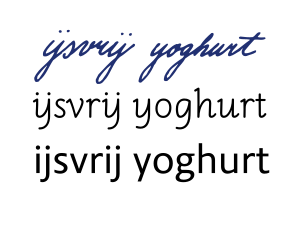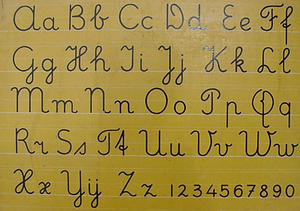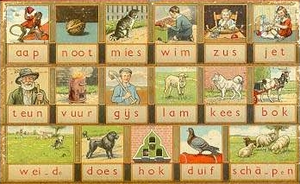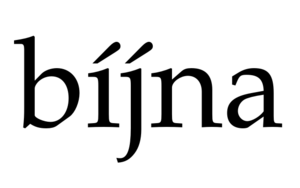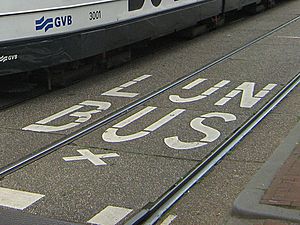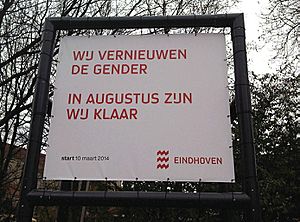IJ (digraph) facts for kids
The IJ (lowercase ij) is a special letter combination in the Dutch language. It's made up of the letters i and j. This combination is called a digraph, meaning two letters that make one sound. Sometimes, people even think of ij as a single letter or a ligature (where two letters are joined together).
In Dutch, the ij usually makes a specific sound, like the "ay" in "say." This sound can also be spelled ei. This often confuses Dutch schoolchildren! To help them, ij is called the lange ij ("long ij"). The ei is called korte ei ("short ei"). In some Dutch areas, like West Flemish, they still pronounce ei and ij differently.
The ij sound can be tricky for people who don't speak Dutch. It's also different from the letter y. In the past, the letter Y was sometimes used instead of IJ, especially for capital letters. But this is not common anymore. However, when you say the Dutch alphabet, the letter Y is still pronounced like ij! In subjects like mathematics and physics, the symbol y is also usually pronounced ij.
To tell the Y apart from IJ in everyday talk, Y is often called Griekse ij ("Greek Y"). This comes from the French phrase i-grec. In modern Dutch, the letter Y is mostly found in words borrowed from other languages or in proper names. Interestingly, in Afrikaans, a language related to Dutch, IJ has been completely replaced by Y.
However, the old use of Y in Dutch names still exists. Especially for Dutch immigrants in countries like the United States and Canada. Their IJ surnames often became Y due to anglicization. For example, Spijker became Spyker, and Snijder became Snyder.
Contents
How the IJ Started
The IJ probably came from writing ii for a long "i" sound. In the Middle Ages, people wrote the letter i without a dot. So, ıı looked a lot like u. To avoid confusion, the second i was made longer, looking like ıȷ. Later, the dots were added back. This is why it's sometimes called the lange ij ("long ij").
Another idea is that the letter J started as a fancy way to write i. In other languages, j was used for the last i in Roman numerals like iij (for three). This stopped people from adding an extra i to cheat. In Dutch, which already had ii, the same rule was used, leading to ij.
A different theory suggests IJ came from the lowercase y being written in two strokes. Around the 15th or 16th century, this combination started to be written as a single ij ligature.
Over time, the sound of ij changed in most words to be like ei. But the spelling stayed the same. Today, ij mostly makes the "ay" sound. However, in the suffix -lijk (like in "eindelijk"), it sounds more like a soft "uh" sound.
In some proper names, ij appears at the end of other vowel sounds, like aaij or ooij. It doesn't change the pronunciation. This comes from an old way of writing y after another vowel. Later, y and ij were seen as the same, so spellings with ij were used. While spelling rules have removed these extra js from common words, old proper names still use them.
Is IJ a Single Letter?
The rules for IJ are different from other two-letter combinations in Dutch. This makes it confusing not just for people learning Dutch, but also for native speakers! How it's used in the Netherlands and Flanders (Belgium) can be different from official advice.
Official View on IJ
The official Dutch Language Union and the group Genootschap Onze Taal say that ij is a digraph. This means it's a combination of i and j. The big Dutch dictionary, Van Dale Groot woordenboek van de Nederlandse taal, says ij is a "letter combination."
However, the Winkler Prins encyclopedia says ij is the 25th letter of the Dutch alphabet. But most people don't agree with this.
When i and j are in different parts of a word, they don't form the ij digraph. For example, in the word gummi-jas, the i and j are separate.
IJ in the Netherlands
In the Netherlands, IJ is often treated like a single letter:
- Many Dutch primary schools used to teach ij as the 25th letter of the alphabet. Some school materials still show it this way.
- When a word starting with IJ is capitalized, both letters become capital: IJsselmeer or IJmuiden.
- Old Dutch typewriters even had a special key for ij that typed it as one character. Modern computer keyboards don't have this.
- In some word puzzles, like the game Lingo, ij takes up only one square. But in others, like Scrabble, it takes two.
IJ in Flanders (Belgium)
In Flanders, schools generally teach IJ as two separate letters.
- Just like in the Netherlands, words starting with IJ usually capitalize both letters: IJzer, IJzertoren.
How IJ is Used
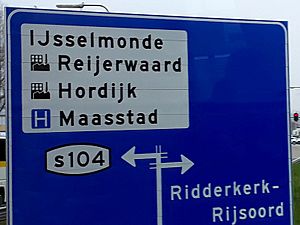
Capitalizing IJ
When a Dutch word starts with IJ and needs to be capitalized, both letters become capital letters. For example, you write IJsselmeer or IJmuiden.
Sometimes, computer programs don't handle this correctly. They might make the second letter lowercase by mistake. This can happen in informal writing or on websites that don't have good language settings.
Sorting Words with IJ
Since about 1850, Dutch dictionaries sort ij as an i followed by a j. So, words with ij come between words with ih and ik. This is the way the Taalunie (Dutch Language Union) prefers it.
However, some encyclopedias, like the Winkler Prins, sort ij as a single letter. They place it between x and y.
In the Netherlands, telephone books and Yellow Pages sort ij and y together. This helps people find names that sound similar, like Bruijn and Bruyn, in the same place. But Bruin, even though it sounds the same, is sorted differently.
Shortening Names
When names are shortened to their initials in the Netherlands, a name starting with IJ is shortened to IJ. For example, IJsbrand Eises Ypma becomes IJ. E. Ypma. Other two-letter combinations in Dutch are shortened to just one letter.
Showing Stress
In Dutch, you can show which part of a word is stressed by adding an acute accent (like this: ´) over the vowel. If it's a two-vowel sound or a digraph like IJ, both vowels should get an accent. So, for IJ, both the I and the J should have an accent.
However, because of computer limitations, the accent on the j is often left out. So you might see "bíjna" instead of "bíj́na". It is possible to combine characters in computers to make a j with an accent, but not all fonts or systems can show it correctly.
Spelling Out Words
When you spell out a Dutch word like Vrijdag, you can do it in two ways, depending on if you think ij is one letter or two:
- V – R – IJ – D – A – G (treating IJ as one)
- V – R – I – J – D – A – G (treating I and J separately)
Spacing in Words
When words are written with wide spaces between letters, IJ is often kept together. For example, F r a n k r ij k is preferred over F r a n k r i j k.
If words are written vertically, from top to bottom, IJ is usually kept together as well.
|
F |
or |
F |
Spelling in Names
In Dutch names, the letters i, ij, and y are often swapped around. Sometimes, names are changed for business reasons or just by accident:
- Johan Cruijff/Cruyff, a famous football player
- Ruud van Nistelrooij/Nistelrooy, another football player
- Piet Heijn/Heyn/Hein, a Dutch admiral
- Dirk Kuijt/Kuyt, a football player
- Arie Luijendijk/Luyendyk, a race car driver
- Spijker/Spyker, a car company
- Anner Bijlsma/Bylsma, a cellist
The Dutch football team Feyenoord changed its name from "Feijenoord" to "Feyenoord". They did this after becoming famous internationally, because foreign people often mispronounced the original name. The Feijenoord district in Rotterdam, where the club is from, still uses the original spelling.
Radio Alphabet
In the Dutch phonetic radio alphabet, the word IJmuiden stands for the IJ. This is different from Ypsilon, which is used for the letter Y. However, the Dutch and Belgian armed forces use the official NATO phonetic alphabet. There, "Y" is "Yankee," and "IJ" is spelled out as "India Juliett."
Word Games
In most crossword puzzles and the game Lingo, IJ is treated as one letter and fills one square. But IJ and Y are still seen as different.
The Dutch version of Scrabble has a Y tile. Some players used it for IJ or Y. Newer versions of the game make it clear that Y is only Y, and IJ must be made from an I tile and a J tile. Older Scrabble editions sometimes had a single IJ tile.
In word games that separate vowels and consonants, IJ is usually considered a vowel if it's treated as one letter. Whether Y is a vowel or consonant is another debate!
Technical Details
Print and Handwriting
In printed text, the letter ÿ (lowercase y with two dots) and ij look very different. But in handwriting, ÿ, ij, Y, and IJ can look almost the same. However, the letter ÿ is very rare in Dutch.
The "long ij" goes below the line, so it's written with a long stroke. It's often written as a single sign, even in handwriting where letters aren't usually joined.
On some road signs in the Netherlands, IJ looks like a single letter shaped like a U with a break in its left side.
Braille
Dutch Braille, used in the Netherlands, uses the Braille symbol for y to represent ij. The Braille symbol for y itself is then written differently. In Belgium, French Braille is used, where ij is simply written as i followed by j.
Computer Encoding
The Dutch ij isn't in the basic ASCII code or most ISO 8859 character sets. So, it's usually written as an i followed by a j. In Unicode, there are special characters for the IJ ligature (IJ and ij). But it's still recommended to use i and j separately, even with Unicode.
Keyboards
While old Dutch typewriters often had a separate key for ij, Belgian typewriters did not. Modern computer keyboards, whether Dutch QWERTY or Belgian AZERTY, don't have a special key for ij or IJ.
When IJ is Not a Digraph
Sometimes, the i and j are next to each other but belong to different parts of a word. In these cases, they don't form the ij digraph. For example, in the word bijectie (which means a type of mathematical function), the i and j are in separate syllables.
This also applies to words with older spellings like minijurk (mini-dress), skijas (ski jacket), or foreign place names like Beijing and Fiji. In these words, the i and j are treated as separate letters. The rules about sorting ij like y or keeping ij together in puzzles don't apply here.



